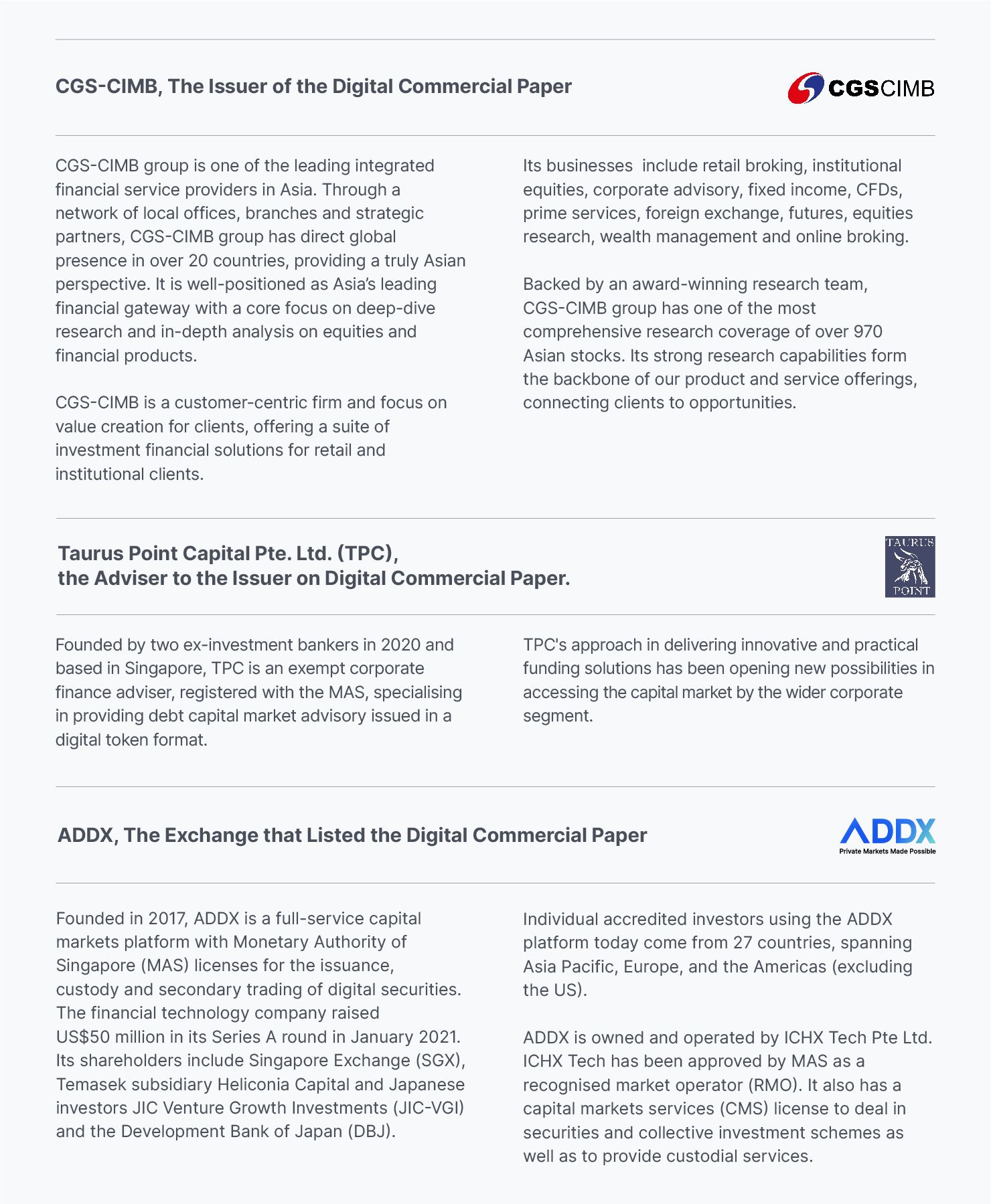
Digital commercial papers are similar to traditional ones, but with a twist – they are issued using blockchain and smart contract technology, making them more efficient to administer. They represent one application of digital securities, an innovation that is quickly catching on in the capital markets and is now being used in a wide range of issuances, including that of equity, bonds and fund units.
In April 2021, one of the earliest digital commercial papers in Asia was issued by financial services provider CGS-CIMB Securities (Singapore) Pte. Ltd. (“CGS-CIMB”) on the private market exchange ADDX. CGS-CIMB established a SGD150-million programme. The first tranche of approximately SGD10 million raised capital from both individual and corporate accredited investors, via a three-month paper. Taurus Point Capital was the adviser to CGS-CIMB for this issuance.
This case study examines what digital commercial papers are, what gap they fill in the current corporate financing landscape, as well as the long-term implications if this instrument becomes widely accepted among issuers and investors.
How companies raise short-term capital today and the pain points they face
Before the advent of digital commercial papers, companies raising funds for the
short term on a non-secured basis had two main options:

Commercial papers are short-term corporate debt with tenures typically between 1 day and 270 days. Traditional commercial papers are expensive to issue because processes are manual and issuers have to work with many intermediaries in the process, from issuance, to custody, to distribution. Due to the higher costs, companies often have to raise over approximately USD100 million to keep cost per dollar raised within a reasonable range. If they have no need for a capital raise of that magnitude, then traditional commercial papers may not be the best option.
Companies can also turn to shorter-term loans or credit facilities by lending institutions. Such loans often come with more flexible tenures than commercial papers and will continue to constitute an important component of a company’s suite of financing options, even as companies grapple with issues such as the lack of price transparency and, in some cases, higher interest rates.
Digital securities as a solution: What are they?
Digital securities, also known as security tokens, are securities that have been issued using blockchain or distributed ledger technology. Unlike traditional securities, they can take a fully digital existence, without the need for physical certificates. Furthermore, the use of self-executing smart contracts allows digital securities to be administered more efficiently.

For example, corporate actions like coupon and dividend payment or cap table management can be automated. Regulators in many jurisdictions have in recent years clarified the rules and regulations around digital securities, paving the way for the growing adoption of the emerging technology across Asia Pacific, Europe
and the Americas.
Singapore is one of the earliest countries to move forward on the use of digital securities. In 2017, the Monetary Authority of Singapore (MAS) clarified that digital securities would be regulated in the same way as traditional securities. This provided the certainty needed by the industry to begin building platforms and exchanges to serve issuers and investors.
In addition, MAS established a regulatory sandbox, which enabled fintech companies to obtain licenses to operate digital securities platforms as long as they could demonstrate that their systems operated smoothly and safely. Singapore is today a leading hub for deals involving digital securities, in Asia and beyond.
The value proposition: Digital securities for short-term corporate financing
For a company looking to raise capital in the short term on an unsecured basis, digital securities bring a number of benefits. Because processes are more efficient and less expensive, issuances can come in relatively small sizes, compared with conventional commercial papers. For example, the first tranche of the CGS-CIMB digital commercial paper programme launched on ADDX was just approximately SGD10 million, whereas the average size per tranche in the conventional commercial paper space needs to be USD100 million or more to make economic sense. This potentially enables many more companies and projects to be financed using commercial papers.
A fully digital commercial paper programme can also be launched in a shorter time. The faster speed to issuance is important, because it reduces uncertainty in the lead-up to the issuance, making it less likely that market conditions would have changed materially from the planning stage of the capital raising project.

She added: “This is the first commercial paper programme we have done in digital
securities form, and it allows us to tap an alternative source of funding and a wider
spectrum of investors. Through this collaboration, we are keen to explore first-hand what digital assets and exchanges might hold for us as a broker in the future. Digital issuances are likely to grow and become a strong complement to traditional capital raising channels.”
Compared with various short-term unsecured loan options by lending institutions, the key advantage of doing a digital commercial paper issuance is the lower borrowing cost. The CGS-CIMB commercial paper carried an interest rate of 1.0% per annum for the first tranche, which had a three-month tenure. For its second three-month tranche, the interest rate was revised to 1.1% per annum to reflect prevailing market conditions.
Following the CGS-CIMB issuance, other companies have begun exploring this new borrowing channel, including ValueMax, a company listed on the mainboard of the Singapore Exchange. ValueMax announced in October 2021 a SGD100-million digital commercial paper programme to be issued through the ADDX platform.
How do investors who buy commercial papers benefit? For individual and corporate investors, a three-month SGD commercial paper that yielded 1.0% per annum was an attractive short-term alternative to bank fixed deposits. At the time of CGS-CIMB’s first paper in April 2021, bank fixed deposits were only yielding half that rate or less.

Oi-Yee Choo, Chief Commercial Officer of ADDX, said: “Commercial papers are suitable for investors looking for a low-risk cash management solution. Investors earn a better yield on funds that are undeployed for various reasons. These may be funds that are in between investments or that have been earmarked for an expenditure item in the near term, such as university tuition fees or a property down payment.”
“Compared with a fixed deposit at a bank, a commercial paper investment offers a significantly higher interest rate. It also helps the investor avoid the risk of incurring a penalty should there be a need to withdraw funds ahead of maturity
– since the ADDX exchange can facilitate the sale of the paper to other investors,” she added.
Conclusion: How digital securities will impact fundraising in the longer term
From time to time, a technological advancement brings about profound change and realignment in an industry. This is true for all sectors of the economy, and the financial services sector is no exception. By opening up a new avenue for capital raising, digital commercial papers in particular and digital securities in general can lead to long-term changes with larger implications, if they come to be widely adopted.
For example, if small and medium private companies with stable businesses can raise capital this way, instead of issuing new equity, the existing shareholders of the company can retain control while expanding their business, giving them the freedom to continue pursuing their current strategy. In the longer run, these companies can choose between staying private and going public, for example, because sources of capital would be available to them either way.
The emergence of a new channel of capital raising also makes the space more competitive. This puts pressure on existing lenders, such as banks, to charge lower fees or innovate to make their businesses more efficient, so that they can keep up with the competition.
On the whole, the innovation will help the capital markets more freely and efficiently, and funds are more likely to be matched with the best and most deserving projects. This drives economic growth and encourages the emergence of well-run companies that will in turn create more jobs in the real economy.
Download the case study here.



